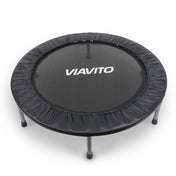Plyometrics go hand in hand with building power. Pushing your body through explosive movements makes you more resilient to everyday tasks. This makes them a perfect accompaniment to your home workout.
What are plyometrics?
Plyometric exercises are quick, explosive movements designed to increase your strength and power. They do this by targeting ‘fast twitch’ muscle fibres. The more muscle fibres you use, the more strength and power you’ll build. As such, plyometrics are impact-heavy and mainly target your core and lower body — think jumps, squats, and powerful landings.
Through a non-stop combo of power and cardio movements, plyometric circuits train your body to build strength by engaging multiple muscles. The result? Functional fitness training proven to improve your balance, endurance and strength.
The Benefits:
- Build core strength
- Muscle definition
- Boost speed and agility
- Increase endurance
- Pack in cardio
PT tip: perfect your form. With plyometrics, form is essential. Perfecting it helps to avoid injury and guarantee an effective, efficient workout.
Plyometric exercises to build power
Mix up your plyometric workout with a combination upper body, lower body and core exercises. Below we share some examples of simple moves you can add into your home workout immediately.
Squat Jumps
Waste time waiting for the lift because you can’t hack the stairs? Try squat jumps. Start with a regular squat, then engage your core and push through your upper legs into an explosive jump. These dynamic movements combine cardio and plyos to strengthen your glutes, hamstrings, quads and core muscles, and burn fat too.
PT tip: Level-up to Sumo squat jumps and strengthen your adductors and hip flexors too.
Cross Jumps
Increase your lower-body power with cross jumps. Simple enough, but tough on the legs. The jumps engage your calves, quads and hamstrings — targeting multiple muscles in a single movement. Anyone can benefit from cross jumps — from those just looking to increase muscle definition to overachievers running the London marathon.
Clapping Press Ups
Plyometrics aren’t just limited to the lower body. Upgrade your standard press-up to clapping ones for a plyometric payoff. The added force needed to push yourself into the air and impact landings are great for increasing upper body power in your pecs, biceps, lats, trapezius and as well as your core. Their increased range of motion helps to increase shoulder mobility too.
Depth Jumps
Reduce the impact of sitting all day with depth jumps. Increase your power by letting yourself “fall” off a box before jumping straight back up. These non-stop exercises make them twice as tough, for double the pay-off. So while you’ll mainly feel the effect in your quads, depth jumps engage your entire body. ARMS, LEGS, CORE. DONE.
PT tip: focus on those quick landings. Spend as little time as possible on the ground, and aim to jump back up ASAP.

